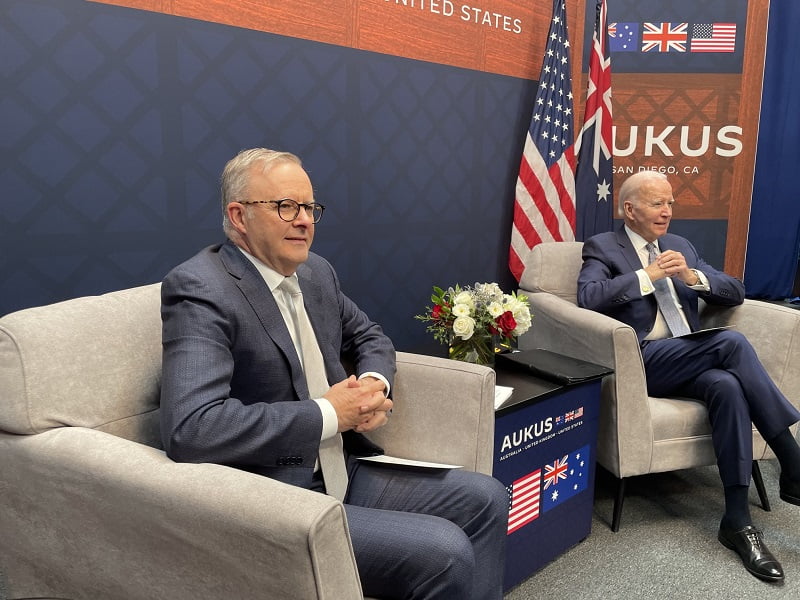Prime Minister Anthony Albanese has heralded Australia’s submarine deal with Britain and the United States as a “catalyst for innovation and research breakthroughs” that will grow the country’s economy for decades to come.
Unveiling the details of the historic agreement alongside US President Joe Biden and UK Prime Minister Rishi Sunak in San Diego, California on Tuesday morning, Mr Albanese said the AUKUS arrangements represents a “unique opportunity” for the advanced manufacturing and technology sectors.
“Built by innovation and extraordinary and emerging technologies, these boats will create a unique opportunity for Australian companies to contribute – not only to the construction and sustainment of Australia’s new submarines, but to supply chains in America and in Britain,” Mr Albanese said.
Australia is poised to acquire up to five Virginia-class nuclear powered submarines from the US for delivery in early 2030 to plug a capability gap left by the Collins-class submarines, while it builds a new fleet of nuclear submarines based on a British design.
Construction on the new SSN-AUKUS submarines is expected to begin in Adelaide-based shipyard later this decade for delivery from early 2040. The United Kingdom is planning to deliver its first SNN-AUKUS submarine in late 2030.

At a cost of $368 billion over the next 30 years, the Prime Minister likened the significance of the project to the birth of the Australian carmaking industry that was initiated by the Chifley Labor government after World War Two.
“The scale, complexity and economic significance of this investment is akin to the creation of the Australian automotive industry in the post-World War Two period,” Mr Albanese.
“And, just as the vision of my predecessors Curtain and Chifley in creating our automotive industry lifted our entire manufacturing sectors, this investment will be a catalyst for innovation and research breakthroughs that will reverberate right across the Australian economy and across every state and territory,” he said.
“Not only in one design element, not just in one field, but right across our advanced manufacturing and technology sectors, creating jobs and growing business right around Australia, inspiring and rewarding innovation, and educating young Australians today for the opportunities of tomorrow.”
Mr Albanese said the “biggest single investment in Australia’s defence capability in our history” would grow the country’s economy for decades, in part by creating around 20,000 direct jobs for Australians in a range of specialisations.
“Engineers, scientists, technicians, submariners, administrators and trades people. Good jobs, with good wages, working to ensure the stability and prosperity of our nations, our region, and our world,” he said.
“Our future security will be built and maintained not just by the courage and professionalism of our defence forces, but by the hard work and know-how of our scientists and engineers, our technicians and programmers, electricians and welders.”
The Commonwealth government will now work with the governments of South Australia and Western Australia – the two states set to benefit the most from the submarine deal – to “develop training programs that equip Australians with the skills they need to fill these jobs”.
“Working together, our universities and research institutes will collaborate to train more Australians in nuclear engineering. We are already sharing skills, and knowledge, and expertise across our borders, lifting the capability and capacity of all three countries,” Mr Albanese said.
A SA Defence Industry Workforce and Skills Taskforce announced as part of the Jobs and Skills Summit last year has already spent the last six months exploring potential workforce issues presented by the AUKUS deal.
Earlier this month, the South Australian Premier Peter Malinauskas announced the first of five new technical colleges aimed at producing the skilled workforce to build the submarines of the future.
Do you know more? Contact James Riley via Email.

